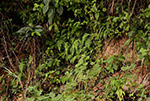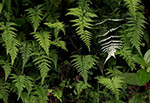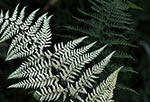Pityrogramma calomelanos (L.) Link var. calomelanos
Synonyms |
Acrostichum calomelanos L. |
|---|---|
Common name |
|
Description |
Rhizome erect to shortly creeping, up to 10 mm in diameter; scales light brown, linear, up to 4 mm long, margins entire. Fronds tufted, arching, firmly herbaceous. Stipe 6-36 cm long, black to chestnut brown, shiny smooth with few scales at the base. Lamina 14-37 × 7-14 cm, ovate to lanceolate in outline, 2- to 3-pinnatifid, long tapering to the apex. Pinnae oblong-lanceolate to narrowly lanceolate, pinnatifid to varying degree, apices acute, margins shallowly toothed and inrolled in dried material, dark green above and covered with a white powder below, glabrous on both surfaces. Rhachis black to chestnut brown, shiny, glabrous. Sori about 3 mm long, situated along the veins in the outer half of the lamina between the costule and margin, often difficult to see because of the yellow powder; exindusiate. |
Notes | Could be confused with P. argentea but the latter has more delicate and more divided (3- or 4-pinnatifid, broadly ovate to triangular fronds. |
Derivation | calomelanos: beautifully black, referring to the colour of stipe and rhachis |
Habitat | Shady banks, clearings, banks near water, ditches, mostly in forest. |
Distribution worldwide | Introduced from Tropical America. Found in Africa, Malagasy and on the Comoro islands. |
Distribution in Africa |
Angola, Benin, Burkina Fasso, Burundi, Cameroon, Congo, Dem. Republic of Congo, Equatorial Guinea (incl. Bioko), Gabon, Ghana, Guinea, Ivory Coast, Kenya, Liberia, Mozambique, Nigeria, Rwanda, Senegal, Sierra Leone, Somalia, Tanzania , Uganda. |
Growth form |
Lithophytic, terrestrial. |
Literature |
|


